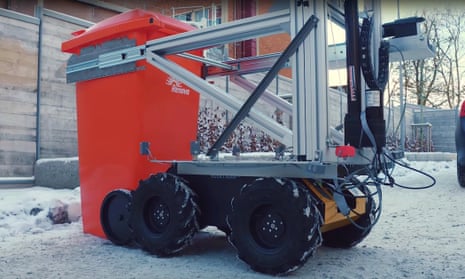Volvo’s latest research prototype uses a small robot to pick up and empty bins into a rubbish truck, guided by an overhead drone and without the need for humans – but Britain’s binmen should not fear for their jobs just yet.
The Robot-based Autonomous Refuse (Roar) handling system is the product of Volvo’s collaboration with Sweden’s Chalmers University of Technology and Mälardalen University, Penn State University in the US, and recycling company Renova.
The system is intended to remove the need for a bin lorry driver to exit the vehicle to pick up refuse. Instead, a drone launches from the top of the lorry, scans the area below and identifies the target bins.
A robot is then deployed to go and pick up the bin, carry it back to the lorry and attach it to the emptying mechanism at the back of the truck. Once the bin has been emptied, the robot returns the bin to its original location and heads off in the direction of the next bin that has been scouted out by the drone.
Per-Lage Götvall, project manager for robot development at Volvo, said: “We predict a future with more automation.
“For us at the Volvo Group, the safety aspect forms the basis of everything we do. Accordingly, many of the robot’s sensors are also used to ensure safety.”
The robot uses various sensors to get the job done, similar to an autonomous car, including GPS, cameras, lidar and built-in maps of the streets and buildings.
The bin lorry driver can monitor the robot’s progress using live feeds from cameras on the truck and take manual control of it. An automated safety system uses cameras and sensors to track people entering the area to stop the robot, should it become dangerous.
The Roar system was designed and developed to prototype-testing phase in four months by 35 students across the three universities, but judging by testing videos, binmen have little to worry about just yet.
Götvall said: “This project is intended to stimulate our imagination, to test new concepts that may shape transport solutions of the future.”
While Volvo is looking at replacing people on the streets, rivals Mercedes-Benz, Toyota and others have been replacing robots with a more adaptable alternative, people, on its production lines.
